SALAMPASU
(ASALAMPASU,
BASALAMPASU, MPASU)
Democratic Republic
of the Congo
The
60,000 Salampasu people live east of the Kasai River, on the frontier
between the Democratic Republic of the Congo and Angola. Their name is said
to mean “hunters of locusts”, but they were widely viewed with terror by
adjacent groups. They maintain strong commercial and cultural relations with
their southern neighbors, the Chokwe and the Lunda to whom they pay tribute.
The Salampasu are homogeneous people governed by territorial chiefs, who
supervise village chiefs. Their hierarchical power structure is
counterbalanced by a warriors' society. A people with a reputation as
fearless warriors, the Salampasu have retained the custom of a rough and
primitive life. Warring and hunting are privileged occupations, but the
women do some farming.
Salampasu masks were integral part of the warriors’ society whose primary
task was to protect this small enclave against invasions by outside
kingdoms. Boys were initiated into the warriors’ society through a
circumcision camp, and then rose through its ranks by gaining access to a
hierarchy of masks. Earning the right to wear a mask involved performing
specific deeds and large payments of livestock, drink and other material
goods. Once a man ‘owned’ the mask, other ‘owners’ taught this new member
particular esoteric knowledge associated with it. The Salampasu use masks
made from wood, crocheted raffia, and wood covered with sheets of copper.
Famous Salampasu masks made for initiation purposes are characterized by a
bulging forehead, slanted eyes, a triangular nose and a rectangular mouth
displaying intimidating set of teeth. The heads are often covered with
bamboo or raffia or rattan-like decorations. Presented in a progressive
order to future initiates, they symbolize the three levels of the society:
hunters, warriors, and the chief. Certain masks provoke such terror that
women and children flee the village when they hear the mask's name
pronounced for fear they will die on the spot. Wooden masks covered or not
covered with copper sheets are worn by members of the ibuku warrior
association who have killed in battle. The masks made of plaited raffia
fiber are used by the idangani association. Throughout the southern
savannah region copper was a prerogative of leadership, used to legitimize a
person’s or a group’s control of the majority of the people. Possessing many
masks indicated not only wealth but also knowledge. Filing teeth making part
of many wooden masks was part of the initiation process for both boys and
girls designed to demonstrate the novices’ strength and discipline.
Salampasu masquerades were held in wooden enclosures decorated with
anthropomorphic figures carved in relief. The costume, composed of animal
skins, feathers, and fibers, is as important as the mask itself. It has been
sacralized, and the spirit dwells within it. Masks are still being danced as
part of male circumcision ceremonies. |
|
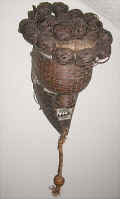
Ceremonial mask. A warrior people
comprising 60,000 individuals, the Salampasu live in Shaba province between
the rivers Lulua and Lueta, tributaries of the Kasai River. Their name is
said to mean “hunters of locusts”, but they were widely viewed with terror
by adjacent groups. They have retained the customs of a rough and primitive
life. The Salampasu live mostly from hunting, but the women do some farming.
The masks, regardless of their material composition, are worn in the
initiation rites of men’s associations, on occasion of bereavement or
enthronement, as well as to pay homage to headhunters. The costume
accompanying this type of mask consists of a fiber net adapted to the body,
and a skirt of fiber or animal fur. The wearer holds antelope horns or a
two-edged sword. Salampasu masquerades were held in wooden enclosures
decorated with anthropomorphic figures carved in relief.
Material: wood, copper sheets,
vegetable fiber
Size: 15" x 10" x 9" |
SENUFO
(SENOUFO, SIENA, SIENNA)
Burkina Faso, Côte d'Ivoire, Ghana and Mali
The Senufo number 1,000,000 to 1,500,000 and
live in Côte d'Ivoire, Ghana, Burkina Faso, and the extreme south of Mali.
They live principally off the fruits of agriculture and occasionally
hunting. Senufo agriculture is typical of the region, including
millet, sorghum, maize, rice, and yams. They also grow bananas, manioc, and
a host of other crops that have been borrowed from cultures throughout the
world. Small farm animals such as sheep, goats, chickens, guinea fowl, and
dogs are raised. Minimal amounts of hunting and fishing also contribute to
the local economy. Labor is divided between farmers and skilled artisans,
and while it was once thought that these segments of society did not
intermarry, In addition to a belief in a creator deity,
ancestors and nature spirits, a central concept in Senufo religion is a
female ancestral spirit called “ancient mother” or “ancient woman,” the
sacred guiding spirit of each poro society. All adult men belong to
the poro society, which maintains the continuity of religious and
historical traditions, especially through the cult of the ancestors. The
poro is the pillar of communal life. Responsible for initiation and
training of the young boys, it is aimed at shaping an accomplished, social
man who is integrated to the collective; it aids his entry into public
responsibilities. A woman’s association, the sandogo, in charge of
divination, is responsible for contact with the bush spirit who might be
bothered by the activities of the hunt, farming, or of artisans.
The
Senufo produce a rich variety of sculptures, mainly associated with the
poro society. The sculptors and metal smiths, endogamous groups
responsible for making the cult objects live on their own in a separate part
of the village. The attitude shown toward them by other Senufo is a mixture
of fear and respect, owing to their privileged relationship with the natural
forces that they are capable of channeling in a sculpture. During
initiations, headpieces are worn that have a flat, vertical, round or
rectangular board on top decorated with paint or pierced work. Many wood
carvings of male figures depict these headpieces, sometimes on rhythm
pounders used by young initiates, who beat the earth to call upon the
ancestors to take part in the ceremony and purify the earth. The
carvers also produce ritual female statues, including mother-and-child
figures, as well as statuettes depicting bush spirits and supernatural
beings and equestrian figures. Large statues representing hornbills
(often seen also on masks) and used in the lo society as symbols of
fertility are the standing birds called porpianong. Figures of the
hornbill are used in initiation, and groups of birds on a pole are trophies
for the best farmer. Figures of male and female twins and of horsemen are
used in divination. These represent the spirit familiars enabling the
divination process. Shrine doors and drums are carved in relief, and small
figures and ritual rings are cast in bronze.
Several types
of mask are used depending upon the occasion. The kpelie, a human
face with projections all around, is said to remind initiates of human
imperfection. Danced by men, these masks perform as female characters.
Animal-head masks usually combine characteristics of several
creatures--hyena, warthog, and antelope. A type of animal mask called
waniugo has a cup for a magical substance on top; these masks blow
sparks from their muzzles in a nighttime ritual protecting the village from
sorcerers. Among the Naffara group of the Senufo, masks of similar form but
with an interior cavity too small for a human head are carried on the top
corner of a rectangular, tent like costume called kagba. This mask is
the symbol of the Lo, which only initiates may see. In the Korhogo
region, deguele masks appear in pairs at funerals. They are of plain
helmet shapes topped with figures whose bodies are carved to resemble a pile
of rings. |
|
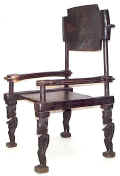 Chair Chair
Unlike stools, Chairs in Africa are thought to have
been influenced by European models. However, each group incorporates its own
styles into the chair design. Used by elders for seating.
Materia: wood
Size: 40" x 23" x 22" |
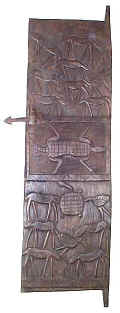
Door. . The Senufo
produce a rich variety of sculptures, mainly associated with the Poro
society, to which adult men belong and which maintains the continuity of
religious and historical traditions, especially through the cult of the
ancestors. Senufo carved doors decorate initiation training houses and
household protective shrines. Their motifs are associated with esoteric
knowledge of divination, bush spirits, and other sources of power, which are
acquired secretly in order to combat forces that threaten communal
well-being.
Material: wood.
Size: 68" x 19" x 2" |
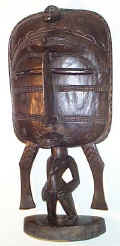
Material: wood
Size: 38" x 19" x 9" |

Female rhythm pounder (deble). The Senufo, about 1
million in number, live mostly in Cote d’Ivoire, but also in Ghana, Burkina
Faso and the extreme south of Mali. They are concentrated in villages
composed of 800 to 1200 inhabitants, broken up into units of matrilineal
lineage descending from a common ancestor. Endogamy within the lineage was
forbidden and punishable by death.
The Senufo produce a rich variety of sculptures, mainly associated with the
Poro society, to which adult men belong and which maintains the
continuity of religious and historical traditions, especially through the
cult of the ancestors. They have a vital masquerading tradition associated
with various male societies, including Poro. Pounders
made from a single piece of wood on a circular base are used to provide the
rhythm for a dance in the Lo society. Such implements are also used
to invoke the spirits of the ancestors, especially at agricultural
ceremonies. Such figures are pounded against the ground in time to the
music.
Material: wood
Size: 63" x 12" x 12" |
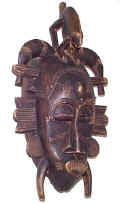
Kpelie initiation mask.
The Senufo produce a rich variety of
sculptures, mainly associated with the Poro society, to which adult
men belong and which maintains the continuity of religious and historical
traditions, especially through the cult of the ancestors. The kpelie
is an ancestor mask, which is used at the ceremony of the lo
society which governed the social life of the tribe. Although the occasions on which it is used may differ, it always
represents the face of a female ancestor with formerly common tatooes,
closely connected to the society’s origin. According to one source, the
kpelie is said to remind initiates of human imperfection. Worn at a
funeral, the kpelie masks serve to compel the spirit of the deceased
to leave the house.
Material:
wood
Size:
16" x 10" x 4" |
|
40" x 23" x 22" |
68" x 19" x 2" |
38" x 19" x 9" |
63" x 12" x 12" |
16" x 10" x 4" |

Wanyugo helmet mask. In
the southern Senufo region a society known as wabele battles sorcery
or negative influences and harmful spirits that appear in form of wild
animals or monsters and threaten people in times of crisis or vulnerability.
The society’s most important paraphernalia are wanyugo masks, which
are considered especially dangerous, even being said to occasionally breathe
fire or emit swarms of bees. Design features recalling various wild animals
underscore the mask’s aggressiveness: powerful jaws with sharp teeth
represent a crocodile’s or hyena’s snout. The mask has extraordinary powers,
which came into play in the context of a ceremony.
Material: wood
Size: 12" x 9" x 19 |

Equestrian figure (Syonfolo).
Most Senufo diviners receive their training as members of Sandogo, a
powerful women’s organization that unites female leaders from a community’s
various households. Senufo wood and copper-alloy figures that depict
equestrian warriors, such as this one, are not essential components of a
Sando (member of Sandogo) diviner’ kit. Instead, they constitute
artistically accomplished tributes to the professional success of the
diviners who commissioned them. The dazzling beauty of these prestige
pieces, amplifies the efficacy of the diviner’s basic set of implements by
enhancing her ability to attract the interest and favor. Since only the most
successful diviners can afford to engage the sculptors to create such works,
their ownership and display in turn indicate to the community at large the
diviner’s attainment of an exceptional level of professional competence.
Material: wood
Size: 35" x 7" x 8" |

Stools 13" x 16" x 16" each |

11" x 23" x 11" |
 11" x 19" x 16" and
22" x 11" x 15" |
|
SONGYE (BASONGE, BAYEMBE, SONGE, SONGHAY,
WASONGA)
Democratic Republic of the Congo
During the 16th century, the Songye migrated from the Shaba area, which is
now the southern part of the Democratic Republic of the Congo. Their history
is closely linked to the Luba's, to whom the Songye are related through
common ancestors. Having waged war against one another for a long time, the
Songye and Luba later formed an alliance to fight the Arabs. They settled on
the left bank of the Lualaba River, on a savanna and forest-covered plateau.
Divided into many subgroups, the 150,000 Songye people are governed by a
central chief assisted by innumerable secret societies.
The
Songye traditionally relied mostly on farming and hunting for subsistence.
Because the rivers were associated with the spirits of deceased chiefs who
were often buried in them, fishing was not practiced except in times of
great need. The artistic wares of the Songye, including pottery made by
women and weaving and metalworking done by men, were traded extensively with
their neighbors.
The Songye created a sculptural style of intense dynamism and vitality. The
works of Songye craftsmen are often used within the secret societies during
various ceremonies. They produced a large number of figures belonging to the
fetishist, who manipulates them during the rituals of the full moon. Songye
fetish figures vary in size from 4” to 60”. They are usually male and stand
on a base. Strips of metal, nails or other paraphernalia are sometimes
applied over the face, which counteract evil spirits and aggressors and
channel lightings against them. The top of the head and the abdomen are
usually hollowed to allow insertion of fetish material, called boanga.
These figures adopt a hieratic posture, the hands placed on a pointed
abdomen; on top of the head they have a horn or feathers reinforcing a
disquieting appearance. The fetishist would make the boanga with
magic ingredients, which he crumbled and mixed, thus obtaining a paste that
was kept in an antelope horn hung from the roof of the house. The magic
ingredients consist of a wide variety of animal, vegetal, mineral and human
substances that activate and bring into play benevolent ancestral spirits.
The face is often covered with nails, a reminder of smallpox. The style of
Songye fetishes, carved from wood or horn and decorated with shells, is not
as realistic as the classic Luba style, and their integration of
non-naturalistic, more geometric forms is impressive. The figures are used
to ensure their success, fertility, and wealth and to protect people against
hostile forces as lightning, as well as against diseases such as smallpox,
very common in that region. While smaller figures of this type were kept and
consulted by individuals, larger ones were responsible for ensuring the
welfare of an entire community.
In the Songye language, a mask is a kifwebe:
this term has been given to masks representing spirits and characterized by
striations. Depending on the region, it may be dark with white strips, or
the reverse. The kifwebe masks embodied supernatural forces. The
kifwebe society used them to ward off disaster or any threat. The masks,
supplemented by a woven costume and a long beard of raffia bast, dance at
various ceremonies. They are worn by men who act as police at the behest of
a ruler, or to intimidate the enemy. It can be either masculine, if carved
with a central crest, or feminine if displaying a plain coiffure. The size
of the crest determines the magic power of the mask. Mask, colors, and
costume all have symbolic meaning. The dancer who wears the male mask will
display aggressive and uncontrolled behavior with the aim of encouraging
social conformity, whereas the dancer who wears the female mask display more
gentle and controlled movements and is assumed to be associated with
reproduction ceremonies. The use of white on the mask symbolizes positive
concepts such as purity and peace, the moon and light. Red is associated
with blood and fire, courage and fortitude, but also with danger and evil.
Female masks essentially reflect positive forces and appear principally in
dances held at night, such as during lunar ceremonies and at the investiture
or death of a ruler. The mask had also the capacity to heal by means of the
supernatural force it was supposed to incorporate. The ritual of exorcism
consisted of holding the sick man’s mask while a magician acted as if he
were casting it into the fire. Kifwebe mask representations also
appear on other objects belonging to the kifwebe society – grooved
shields, for example, are adorned with a central mask. Buffalo masks with a
brown patina that have no stripes were used in hunting rituals.
The Songye also produce prestige stools,
ceremonial axes, made of iron and copper and decorated with interlaced
patterns, neckrests, bracelets and copper adzes.
|
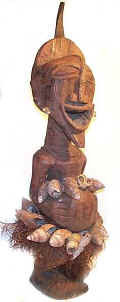
Songye (Basonge, Bayembe, Songe, Wasonga),
Democratic Republic of the Congo
Fetish. The 150,000
Songye settled in the southeast of the country have a strong interest in
magic, which affects many aspects of their lives. The Songye carvers excel
in the production of fetishes and expressionistic masks.
Songye fetish figures vary in size from 4”
to 60”. While smaller figures of
this type were kept and consulted by individuals, larger ones were
responsible for ensuring the welfare of an entire community.
These figures adopt a hieratic posture, the
hands placed on the abdomen; on top of the head they may have a horn
reinforcing a disquieting appearance.
The top of the head and the abdomen are
usually hollowed to allow insertion of fetish material, called boanga.
The fetishist would make the boanga with magic ingredients, which he
crumbled and mixed, thus obtaining a paste that was kept in an antelope horn
hung from the roof of the house. The magic ingredients consist of a wide
variety of animal, vegetal, mineral and human substances that activate and
bring into play benevolent ancestral spirits. The fetishes
are intended to ward off evil, to preserve the tribe or the family from
hostile powers, sorcerers or evil spirits, and to aid fertility.
Material: wood, shells, rafia |

Songye (Basonge, Bayembe, Songe, Wasonga),
Democratic Republic of the Congo
Chief’s staff. Many of ancient Songye
traditions have survived, among them the use of staffs as emblems of
leadership.
Chief’s staffs were both prestige items and receptacles for sacral power.
Sanctified by ritual specialists, they took on supernatural qualities and
were said to have healing power. A Songye staff is like an enlarged detail
of a map, for a staff tells the story of an individual family, lineage, or
chiefdom. The map is read vertically, from top to bottom. As one progresses
down the staff, it is as if one were journeying across the Songye landscape,
through the uninhabited savanna represented by the plain, unadorned staff.
Material: wood |
 Songye
Game Board Songye
Game Board |
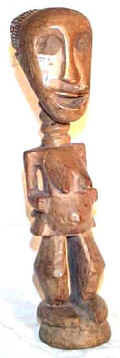
Songye (Basonge, Bayembe, Songe, Wasonga),
Democratic Republic of the Congo
Protective figurine.
The 150,000 Songye live in the southeast of the country. Culturally and
linguistically they are related to the Luba. Divided into numerous
sub-groups, the Songye are governed by a central chief whose role demands
that he obey special restrictive laws such as not showing grief, not
drinking in public and not shaking hands with men. The Songye have a strong
interest in magic, which affects many aspects of their lives. The Songye
create protective figures in a range of sizes. They are thought of as
protectors against physical ailments and aggression from outside and are
aides related to healing and therapy. They also promote fertility. The
present figurine is of this type.
Material: wood |
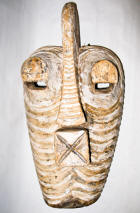 Kifwebe
male mask. In the Songye
language, a mask is a kifwebe;
this term has been given to masks representing spirits. The kifwebe
society used them to ward off disaster or any threat. The mask had also the
capacity to heal by means of the supernatural force it was supposed to
incorporate. The masks, supplemented by a woven costume and a long beard of
raffia bast, dance at various ceremonies. Mask, colors, and costume all have
symbolic meaning. The use of white on the mask symbolizes positive concepts
such as purity and peace, the moon and light. Red is associated with blood
and fire, courage and fortitude, but also with danger and evil. The dancer
who wears the male mask will display aggressive and uncontrolled behavior
with the aim of encouraging social conformity, whereas the dancer who wears the
female mask display more gentle and controlled movements and is assumed to
be associated with reproduction ceremonies.
The female mask distinguishes from the male
one by the absence of a crest on top of the head. The
wave-like pattern of broad stripes in contrasting color may provide a hint
as to the region of origin -- perhaps that of the eastern Songye.
Material: wood
|
|
38" x 13" x 13 |
35" x 4" x 2" |
17" x 8" x 5" |
|
23" x 13" x 11" |
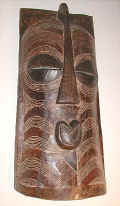 Kifwebe
male mask. In the Songye
language, a mask is a kifwebe;
this term has been given to masks representing spirits. The kifwebe
society used them to ward off disaster or any threat. The mask had also the
capacity to heal by means of the supernatural force it was supposed to
incorporate. The masks, supplemented by a woven costume and a long beard of
raffia bast, dance at various ceremonies. Mask, colors, and costume all have
symbolic meaning. The use of white on the mask symbolizes positive concepts
such as purity and peace, the moon and light. Red is associated with blood
and fire, courage and fortitude, but also with danger and evil. The dancer
who wears the male mask will display aggressive and uncontrolled behavior
with the aim of encouraging social conformity, whereas the dancer who wears the
female mask display more gentle and controlled movements and is assumed to
be associated with reproduction ceremonies.
The female mask distinguishes from the male
one by the absence of a crest on top of the head. The
wave-like pattern of broad stripes in contrasting color may provide a hint
as to the region of origin -- perhaps that of the eastern Songye. Kifwebe
male mask. In the Songye
language, a mask is a kifwebe;
this term has been given to masks representing spirits. The kifwebe
society used them to ward off disaster or any threat. The mask had also the
capacity to heal by means of the supernatural force it was supposed to
incorporate. The masks, supplemented by a woven costume and a long beard of
raffia bast, dance at various ceremonies. Mask, colors, and costume all have
symbolic meaning. The use of white on the mask symbolizes positive concepts
such as purity and peace, the moon and light. Red is associated with blood
and fire, courage and fortitude, but also with danger and evil. The dancer
who wears the male mask will display aggressive and uncontrolled behavior
with the aim of encouraging social conformity, whereas the dancer who wears the
female mask display more gentle and controlled movements and is assumed to
be associated with reproduction ceremonies.
The female mask distinguishes from the male
one by the absence of a crest on top of the head. The
wave-like pattern of broad stripes in contrasting color may provide a hint
as to the region of origin -- perhaps that of the eastern Songye.
Material: wood
Size:
44" x 22" x 9" |
SUKU
(BASUKU)
Democratic Republic
of the Congo
The
80,000 Suku people have lived in the southwestern part of the Democratic
Republic of the Congo since the 16th century. Their main economic resource
is farming. Cultivation of yams, manioc, and groundnuts is done
primarily by women. This is supplemented by the men hunting with dogs in the
surrounding forest and by the women gathering wild berries, nuts, and roots.
Occasional fishing in the Kwango River also provides some food. Although
hunting rarely provides substantial quantities of meat to the Suku diet, it
is considered an important part of male culture. Palm tree plantations
provide the Suku with palm oil, an important commodity for local and
international trade.
The
wood sculpture is a royal court art linked to the social hierarchy. The
statues that contain magic ingredients have malevolent or beneficial
functions. The medications are placed in the figure’s abdomen, which is
closed up with a resin stopper, or enclosed in small bags hung around the
neck or waist. The statue is kept in a hut that stands with in the enclosure
of the chief’s house. The Suku of the north have statues, the
mulomba: these have one hand outstretched to solicit a
gift. The sculptures wear the hairdo typical of the chiefs of the territory
and lineage. The Suku also carve figures, which are used during fertility
ceremonies and kneeling or crouching fetish figures. These are used either
as ancestor figures or as the personification of the evil spirit.
The Suku have
an initiation, the n-khanda. A special hut is built in the forest to
give shelter to the postulants during their retreat; the event ends in
circumcision, an occasion for great masked festivities including dances and
song. The masks fulfill several functions: some serve as protection against
evil forces, others ensure the fertility of the young initiate. Their role
consists in frightening the public, healing the sick, and casting spells.
The charm masks of the initiation specialist do not "dance." Their
appearance must engender terror, especially the
kakuungu,
with its swollen cheeks, massive features, and protruding chin. The Suku
also used hemba
helmet masks. These are cut from a cylinder of wood, the hairdo often
surmounted by a person or animal. These masks are supposedly an image of the
community of deceased elders, notably the chiefs of the maternal lineage.
They are used to promote success in the hunt, to heal, and to punish
criminals. They were also worn by dancers during certain initiation
ceremonies. |
|
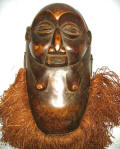 Suku Suku |
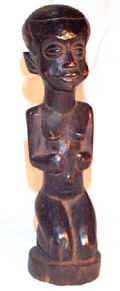 Suku
Protective figurine Suku
Protective figurine |
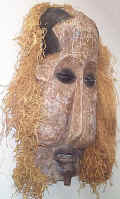
Suku. Kakungu ceremonial mask. The 80,000 Suku inhabit
the Southwest of the DRC. Their main economic resources are farming and
hunt. In Suku society, boys’ coming-of-age preparation is the responsibility
of the Nkanda association. In the seclusion of lodges located outside
the village, boys between the ages of ten and fifteen years are taught the
history and traditions of their people and undergo obligatory circumcision.
They also learn the songs and dances that will be performed at their
initiation ceremonies. Several different masks are used in the Nkanda
graduation ceremonies. Kakungu is the largest of the initiation
masks. The mask appears on the day of circumcision and again when the young
man leaves the lodges to return to the village. Kakungu masks instill
in the young men obedience and respect for their elders. These masks are
also protective, threatening anyone suspected of harboring evil intentions
against the initiates. They are also called upon for the treatment of
impotence and sterility. The kakungu mask has assertive and
impressive form, with a large forehead and bulging cheeks. When not in use,
they are displayed in shrines.
Material: wood, raffia
Size: 36" x 21" x 8" with raffia |
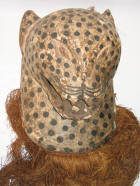 Suku. Ceremonial Mask Suku. Ceremonial Mask
Material: wood, pigments, raffia
Size: 19" x 13" x 11 + raffia
THIS ITEM HAS BEEN SOLD (SWEDEN) |
|
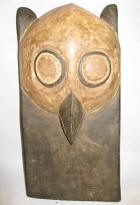
Ceremonial Mask
Material: wood
Size: 24" x 10" x 12" |
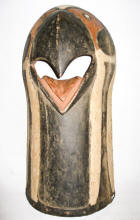
Ceremonial Mask
Material: wood
Size:
27" x 13" x 10" |
TABWA
Democratic Republic of the Congo and Zambia
The Tabwa people lived under Luba domination
in small autonomous villages scattered within a territory that expanded from
the southeast of the Democratic Republic of the Congo to the northeast
of Zambia, along Lake Tanganyika. The verb "tabwa" means "to be tied up"
and refers to when these people were taken as slaves. During the 19th
century, the ivory trade brought wealth to the region and Tabwa people
gained their independence. Today, they number 200,000 and are led by
chiefs-sorcerers who rule over village chiefs and family chiefs. Their power
is counterbalanced by male societies created on Luba prototypes and by
female associations influenced by East African models. Traditionally, Tabwa
people made their living from hunting and blacksmithing; nowadays they
cultivate millet, manioc, cassava, beans, and corn, but they live
primarily off fishing and hunting, for game is plentiful. The
influence of Eastern Tanzanian neighbors on Tabwa art is seen in their use
of linear geometric decorations, while their western neighbors, the Luba,
influenced the incorporation of prestige objects into Tabwa life.
The Tabwa worshipped ancestors, whose statues were the property of the
lineage chiefs and sorcerers; these carried “medications” in their ears or
in small cavities at the top of their heads. The Tabwa also worshipped the
spirits of nature, who lived in trees and rocks. The installation of a
supreme chief is of relatively recent vintage; formerly it was the function
of the large ancestor figures to consolidate the power of the chiefs. Other
statuettes were used for divination. The Tabwa also made twin figures that
could be both dangerous and bearers of good luck. In the north of Tabwa
country, the diviner was also a sculptor; consulted after a dream, he would
create a new statue. Special attention was paid to scarifications, which
embellish the body and recall social values. On the whole surface of the
body, a recurrent motif consists of twinned isosceles triangles, the two
bases of which symbolize the duality of life. They evoke the coming of the
new moon, essential to Tabwa philosophy, whose return would be celebrated
monthly.
The
Tabwa used two types of masks: a human one, which represented woman, and
another in the form of a buffalo head, which represented man. Both would
make an appearance at the time of the fecundity ritual, celebrated for
sterile women. One also finds paddles, combs, and musical instruments with
figurines.
|
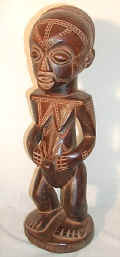
Lake Tanganyika and some part of the northeastern
Zambia. They are led by
chiefs-sorcerers who rule over village chiefs and family chiefs. Their power
is counterbalanced by male societies created on Luba prototypes and by
female associations influenced by East African models. Traditionally, Tabwa
people made their living from hunting and blacksmithing; nowadays they
cultivate millet, manioc, and corn, but they live primarily off fishing
and hunting. The Tabwa worshipped ancestors, whose statues were the property
of the lineage chiefs and sorcerers.
Tabwa lineage elders kept
small wooden images to represent and honor ancestor spirits, great healers,
and occasionally earth spirits. The figure displays elaborate scars. Such
adornment was esthetically pleasing and served as visual metaphors that
implied positive social values and the harmony of natural forces.
Material: wood
Size: 28" x 13" x 10" |
TANZANIA |
|
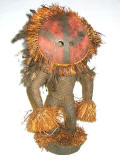 |
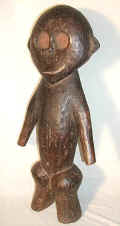
|
|
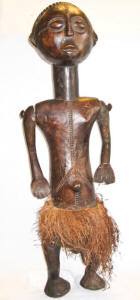 |
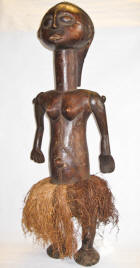 |
|
|
26" x 11" x 4" |
|
41" x 13" x 10" |
41" x 12" x 11" |
|
TEKE (ANZIKA, BAKONO, BATEKE, M'TEKE,TEGE,
TEO, TERE, TSIO)
Both Congo Republics and Gabon
The name of this people indicates its occupation—that is, trading—from
teke, meaning “to buy.” The Teke settled in a territory lying across
Republic of Congo, the Democratic Republic of the Congo and Gabon. During
the 15th century they were integrated into the Tio kingdom, but attained
independence in the 17th century. The basic social unit was the
family, under the authority of the mfumu, or head of the family; the
latter had the right of life and death over all family members and his
prestige grew as their number grew – hence a tendency to own many slaves to
increase one’s power and reputation. In terms of spiritual life, the
mfumu mpugu, the village chief chosen as religious leader, was the most
important personage; he kept the basket that contained the magic statuettes
and the bones of the ancestors. The Teke often chose a blacksmith as chief –
an important person in the community whose profession was passed down from
father to son. The diviner, both sorcerer and healer, was also powerful;
facilitating retributions, he would render effective the mussassi,
personal protective statuettes, and would perform divination in instances of
illness or death. The economy of the Teke is mainly based on
farming maize, millet and tobacco, but the Teke are also hunters, skilled
fishermen and traders. They believe in a supreme being, the creator of the
universe called Nzambi, whose favors can be
obtained with the help of tutelary spirits.
Teke artists carved fetish figures. Three elements are characteristic: a
variety of headdresses, the presence of fine parallel scarifications on the
cheeks, and the addition of fetish materials bonga either in an
abdominal cavity or in a body-enveloping sack from which the head and feet
protrude. Each figure has its own specific purpose not related directly to
its appearance. For example, when a figure is carved for a newborn child,
part of the placenta is placed in the stomach cavity of the figure while the
rest is buried inside the father's hut (where the family's fetish figures
are kept). The figure serves to protect the child until puberty. Figures of
identical appearance serve also for success in hunting, trading, and other
activities, each figure's purpose being known only to the owner. These
figures protect and assist the Teke and, if a fetish figure successfully
demonstrates its power, its owner may detach bonga, break it into
several pieces and insert fragments into other figures. He will then sell
new figures to neighboring families, leaving the original statue with an
emaciated body. The statues with bonga are called butti;
without bonga they are called tege. Often the magical
substance is placed all around the body with a cloth. The arms and hands are
often highly conventionalized, carved in right angles at the elbows and
shoulders, or missing altogether. The bonga is composed of various
materials, but one of the main ingredients is whitish clay or chalk, which,
for the Teke, represents the bones of their ancestor, thus conveying
protective power. Often it is mixed with the nail clippings or the hair of a
venerated person, with leaves of specific plants, various parts of snakes or
leopards, etc. There are also statues with two faces and double legs;
statues without the cavity, called nkiba; sitting figures with
cavities.
The Teke used the moon-shaped masks -- flat, decorated with abstract
geometric motifs, bisected by a horizontal stripe, colored with white or red
earth, painted black, blue, and brown. They portray an abstractly
interpreted human face. At the same time, the design is a composition of
symbols. Teke masks are worn by members of the kidumu society either
during the funerals of chiefs, or weddings, or important meetings.
|
|
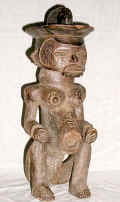
Teke (Anzika, Bakono, Bateke, M’Teke, Tege, Teo,
Tere, Tsio,), both Congo republics and Gabon
Butti statue.
The Teke inhabit the Stenley Pool area, in both Congo republics and also in
Gabon. They are farmers and hunters and live in an area of plateaus covered
by savannah, in villages grouped under a district chief. The Teke believed
in a supreme being, the creator of the universe, called Nzami or
Nziam, but their only cult was an ancestor cult. The power of this
statue was in a magical substance (bonga) contained in the hole made
in the body. Typical is the presence of fine parallel scarification marks on
the cheeks. The butti representing ancestors are believed to
bring success in hunting or trading and to protect against disease. The
healing power of a butti is based on materials with supernatural
qualities determined by the healer or diviner. The magic stuff may be earth
and plant resin mixed with white chalk, small pieces of wood, hair, or other
ingredients.
Materials: wood
Size: 14" x 6" x 6" |
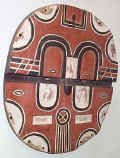
Teke (Anzika, Bakono, Bateke, M’Teke, Tege, Teo,
Tere, Tsio,), both Congo republics and Gabon
Ceremonial Tsaayi
mask. The name of the ethnic group indicates its occupation – that
is, trading – from teke meaning “to buy.” The Teke inhabit the
Stenley Pool area, in both Congo republics, which is an area of plateaus
covered by savannah, in villages grouped under a district chief. They are
farmers and hunters. The Teke believed in a supreme being, the creator of
the universe, called Nziam, but their only cult was an ancestor cult.
This shield like mask is one of the most amazing masks in the whole of
African art, with highly abstract polychrome patterns. The facial features,
eyes, nose, and mouth, are only minor elements in a decorative whole
accentuated by polychrome. At the same time the design is a composition of
symbols. The Teke masquerade dances originally served to confirm and
maintain the social and political structure in a ceremonial context. With
the onset of French colonial rule this tradition began to go into decline,
and it was not until the countries gained independence that it was partly
revived.
Material: wood
Size: 21" x 19" x 3"
|
|
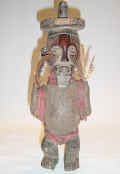 Teke
(Anzika, Bakono, Bateke, M’Teke, Tege, Teo, Tere, Tsio,), both Congo
republics and Gabon Teke
(Anzika, Bakono, Bateke, M’Teke, Tege, Teo, Tere, Tsio,), both Congo
republics and Gabon
Butti statue. The Teke
inhabit the Stenley Pool area, in both Congo republics. They are farmers and
hunters and live in an area of plateaus covered by savannah, in villages
grouped under a district chief. The Teke believed in a supreme being, the
creator of the universe, called Nzami or Nziam, but their only
cult was an ancestor cult. The power of this statue is in a magical
substance (bonga) contained in the sack surrounding the body from
which the head and feet protrude. Typical is the presence of fine parallel
scarification marks on the cheeks. The butti is believed to bring
success in hunting or trading and to protect against disease. The magic
stuff may be earth and plant resin mixed with white chalk, small pieces of
wood, hair, or other ingredients.
Materials: wood, textile, feathers
Size:
|
TOMA
Liberia,
Guinea and Liberia
Settled in the
northwest of Liberia, western Sierra Leone, and eastern Guinea, the 200,000
Toma live in the high-altitude rain forest. They organized their political
and religious life around the poro association. This society was,
among other things, responsible for the initiation of young boys that took
place in the forest, which is particularly dense in the land of the Toma.
When called forth by the landai (landa), a large mask, the
future initiates would leave “on retreat” for the forest for a month. The
landai, a horizontal unusually free, abstract wooden mask, has the mouth
of a crocodile on which human features have been sculpted: a straight nose
underneath arched eyebrows. The jaw is sometimes articulated, sometimes
depicted by a horizontal line that creates a second volume perpendicular to
the first. The top is surmounted by a headdress of feathers and the wearer
looks through the snout. The largest known landai mask was 1.82 m in
height. Its frightening image represented the major forest spirit which made
manifest the power of
poro;
one of its duties was symbolically to devour boys at the end of their
initiation period in order to give them rebirth as men. Only men wore these
masks, which were fitted over the wearer's head horizontally.
The bakrogui, more common and less secret than the landai, are
smaller masks that come in couples. The mask consists of a vertical panel
upon which human features have been inscribed, a bulging nose and forehead,
a beard, and tubular eyes or eyes heightened by metal disks. This mask may
be seen only by members of the poro. Each mask may be thought of as
the spiritual dwelling of an ancestor.
Figures also exist and are kept within each household. They have facial
feature similar to landai masks. |
|
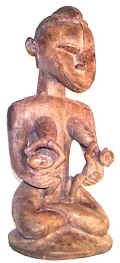 Toma.
Maternity sculprue of mother and twins. Toma.
Maternity sculprue of mother and twins. |
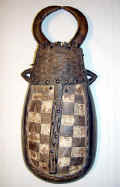
Toma (Loma, Lorma), Liberia, Sierra Leone, Guinea
Nyangbai or bakrogui
mask. Settled in
the northwest of Liberia, western Sierra Leone, and eastern Guinea, the
200,000 Toma live in the high-altitude rain forest. Their most notable
sculptural forms were wooden masks that combined human and animal features.
This mask presents the wife of the great forest spirit. It is worn directly
over the male wearer’s face. The upper part exhibits simplified (cattle or
antelope) horn shapes and a rounded forehead. Usually such female partners
to big male masks help out at periods of initiation and make an appearance
only at important funerals or crisis.
Material: wood |
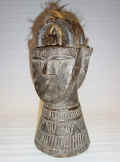 Toma
Crest. Toma
Crest. |
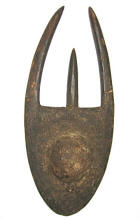
Toma Mask |
|
28" x 12" x" 1" |
23" x 10" x 3" |
13" x 6" x 6" Janus faces |
23" x 10" x 3" |
|
TUAREG
Algeria,
Tunisia, Mali, Libya, Burkina Faso and Niger
The Tuareg are a tribal
people of the Sahara. Today more than 300,000 Tuareg live in Algeria,
Tunisia, Mali, Libya, Burkina Faso, and Niger. They speak a Berber
language, Tamarshak, and have their own alphabet. In ancient times, the
Tuareg controlled the trans-Sahara caravan routes, taxing the goods they
helped to convey and raiding neighboring tribes. In modern times, their
raiding was subdued by the French who ruled Algeria. The political
division of Saharan Africa since the 1960s has made it increasingly
difficult for the Tuareg to maintain their pastoral traditions.
Tuareg society distinguishes among nobles,
vassals, and serfs. Slave-stealing expeditions have been abolished, but
the black descendants of former slaves still perform the menial tasks.
Social status is determined through matrilineal descent. Converted by
the Arabs to Islam, the Tuareg have retained some of their older rites.
Among the Tuareg, for example, men—not women—wear a headdress with a
veil.
Many Tuareg starved in droughts in the
1970s, and others have migrated to cities. After leather,
wood is perhaps the most important material in Saharan daily life, and
is used for the poles and beams of the nomads’ tents on which are hung
bags, saddles, bows and whips, as well as bed frames, dishes, cups,
milking bowls, spoons, mortars and pestles. Among the Tuareg
elegantly sculpted cushion supports (ehel) are important items in
any well-appointed household. They were carved by members of the guild
known as enaden, blacksmiths who have been instrumental in the
creation of precisely those things that have forever distinguished the
upper classes of the society from the many vassal populations of the
Tuareg world. Ehel form part of the basic furnishing found in
any upper-class Tuareg’s tent. Ehel are used to pin the mat-woven
walls against the exterior tent-poles.
|
|

Tuareg, Niger
Cushion support (ehel).
Among the Tuaregs of Nigerelegantly sculpted cushion supports are
important items of any well-appointed household. They were carved by members
of the guild known as Enaden, literally meaning ‘the other’, blacksmiths who
have been instrumental in the creation of precisely those things that
distinguished the upper classes of this society from the many vassal
populations of the Tuareg world. The products of the Enaden are among the
most potent of hegemonic symbols – for in sitting reclining upon the pillows
and ehel, Tuareg nobles literally sit and lean upon these artists,
dramatically re-enacting the historical relationship between themselves and
the members of this guild. Tuareg sitting in his tent is to witness the
fullness of his authority and to realize that he is filled with a sense of
personal superiority that cannot be wrested from him.
Material: wood
Size:54" x 6.5" |
|
|
|
Tusyan
(Toussian, Tusia, Tusian, Win)
Burkina Faso
The Tusyan, a small
ethnic group in southwestern Burkina Faso are known especially for large,
rectangular masks (loniaken) with figurative depiction of buffalo
horns or bird’s head on the upper edge. These elements symbolize the totem
animal of the clan to which the mask’s owner belongs. These masks were part
of the Do or Lo cult into which all adolescents were initiated. In present
case the mask is topped with two bird’s heads, representing the grey
hornbill. During biannual ceremonies which were a precondition for marriage,
the boys were given new, secret names associated with birds or wild animals.
About every forty years, a great initiation rite was held in which those
already initiated took part. Such masks were used exclusively at these great
initiation rites.
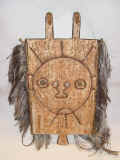
Material: wood, red Abrus
precatorius seeds
Size: 31" x 21" x 3"
|
UNATTRIBUTED |
|
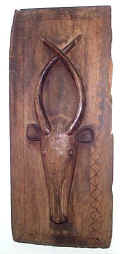 38" x 17" x 4" 38" x 17" x 4" |
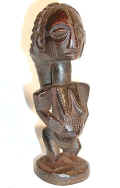
Hemba? Kusu? Luba? |
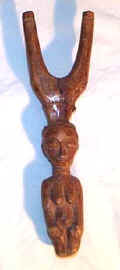 9" x 3" x 4" 9" x 3" x 4"
|
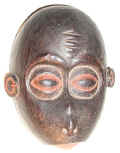
12" x 8" x 3" |
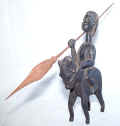 10 x 6" x 2"
not Ashanti |
|
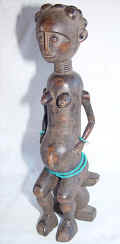 16" x 6" x 5"
not Ashanti 16" x 6" x 5"
not Ashanti |
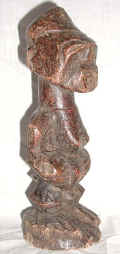 |
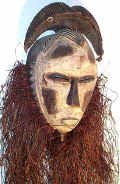
Possibly, Baule or Guro????
18" x 11" x 7" (no raffia on the mask) |
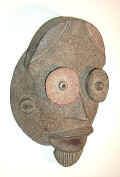
18" x 12" x 8"
|
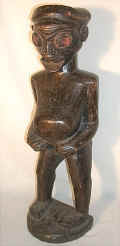
24" x 7" x 6" |
WOYO Woyo (Bahoyo, Bawoyo, Ngoyo)
Democratic Republic of
the Congo and Angola's Cabinda Province
A small tribe located both in the Democratic
Republic of the Congo and in Cabinda (province of Angola), the Woyo live on
the Atlantic Ocean coast, north of the estuary of the Zaire River. As early
as the late fifteenth century, their ancient kingdom was known to Europeans
as that of the Ngoyo.
Living along
the coast allows the Woyo to depend on the sea for much of their food. Men
fish in the ocean, collect coconuts, and make palm wine. They also practice
some hunting and do most of their own smithing. Women also fish, mostly in
local ponds. They contribute significantly to the local economy, farming
corn, manioc, bananas, beans, and pineapple. Surplus food is often traded to
inland neighbors for profit under the supervision of local lineage heads
from individual villages.
The Woyo possess a form of writing that has not yet
been studied. A special application of this writing occurs in their “proverb
covers,” the lids of their realistically carved wooden “storied pots,” which
serve as an ingenious means of communication between husband and wife. Woyo
sculpture shows the influence of their Kongo neighbors, while remaining
stylistically distinct. Numerous types of figural sculptures, which are used
in religious ceremonies, are carved from wood. Their sculpture
includes masks of the ndunga, a male society whose dances mark
particular occasions including installations of tribal elders, funerals,
celebrations, or the presence of great danger. The ndunga masks of
the Woyo are characterized by their large size. These masks are worn with
proportionately voluminous costumes of dried banana leaves that fully cover
the dancers’ body. As a general rule, the masks are polychrome; however,
some are painted primarily white. Believed to have symbolic meaning, the
color is related to the concept of the masks’ power and is sometimes
renewed. Their statues often adorned with magical objects called nkissi,
have a triangular-shaped jaw and enlarged eyes.
|
|
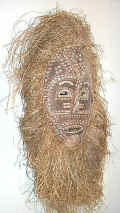
Woyo
(Bahoyo, Bawoyo, Ngoyo), Democratic Republic of the Congo and Cabinda
Ndunga dance
mask. The small Woyo people live on the Atlantic Ocean coast, north
of the estuary of the Zaire River. The Woyo possess a form of writing that
has not yet been studied. A special application of this writing occurs in
their “proverb covers,” the lids of their realistically carved wooden
“storied pots.” Woyo sculpture shows the influence of their Kongo neighbors,
while remaining stylistically distinct. Their sculpture includes masks of
the ndunga, a male society whose dances mark particular occasions
including installations of tribal elders, funerals, celebrations, or the
presence of great danger. These masks are worn with voluminous costumes of
dried banana leaves that fully cover the dancers’ body. As a general rule,
the masks are polychrome.
Material: wood
Size: 22" x 12" x 2"
|
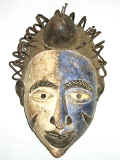 Ndunga dance
mask. The small Woyo people live on the Atlantic Ocean coast, north
of the estuary of the Zaire River. The Woyo possess a form of writing that
has not yet been studied. A special application of this writing occurs in
their “proverb covers,” the lids of their realistically carved wooden
“storied pots.” Their sculpture includes masks of the ndunga, a male
society whose dances mark particular occasions including installations of
tribal elders, funerals, celebrations, or the presence of great danger. They
are also agents of social control that operate like secret police. These
masks are worn with voluminous costumes of dried banana leaves that fully
cover the dancers’ body. As a general rule, the masks are polychrome. The
open mouth reveals a decoratively filed incisor. Ndunga dance
mask. The small Woyo people live on the Atlantic Ocean coast, north
of the estuary of the Zaire River. The Woyo possess a form of writing that
has not yet been studied. A special application of this writing occurs in
their “proverb covers,” the lids of their realistically carved wooden
“storied pots.” Their sculpture includes masks of the ndunga, a male
society whose dances mark particular occasions including installations of
tribal elders, funerals, celebrations, or the presence of great danger. They
are also agents of social control that operate like secret police. These
masks are worn with voluminous costumes of dried banana leaves that fully
cover the dancers’ body. As a general rule, the masks are polychrome. The
open mouth reveals a decoratively filed incisor.
Material:
wood
Size: 13" x 8" x 8" |
|
YAKA
Democratic Republic of the Congo
The
Kwango River area (southwest of the Democratic Republic of the Congo) is the
home of some 300,000 highly artistic Yaka people. Yaka or yakala
means “males,” “the strong ones,” thus Bayaka, “the strong people.” The Yaka
society is organized into strong lineage group headed by elders and lineage
headmen. The chief of the lineage had the power of life and
death over lineage members. He was in charge of the cult of the ancestors
and judiciary authority, and it was compulsory that he have large number of
descendants. Chiefs, including dependent village chiefs, regional
overlords, and paramount chiefs, are believed to have extra-human abilities,
ruling the underworld or spiritual realm as well as the ordinary world. A
chief participates in the affairs of witches so that he can tap their power
for the good of the community. On the periphery of the hierarchy,
the “master of the earth” plays an important role during the rites that
accompany the hunt – the primary activity of the men. The Yaka hunters
perform a specific ritual under the direction of the “master of the earth”
to guarantee that they procure game. The Yaka have an initiation, the
n-khanda. A special hut is built in the forest to give shelter to the
postulants during their retreat; the event ends in circumcision, an occasion
for great masked festivities including dances and songs. The n-khanda
is organized every time there are enough eligible youths between ten and
fifteen years of age.
The arts of the Yaka people are very much
alive today. The statues that contain magic ingredients, the
biteki (nkisi), are multi-functional and sometimes have
contradictory roles, for example, they were used to heal and to cause
illness. The medications are placed in the figure’s abdomen, which
is closed up with a resin stopper, or enclosed in small bags hung around the
neck or waist. All nkisi figures are manipulated by
a diviner to activate a force which can either inflict illness or protect
one’s clan from illness or harm, depending upon the particular set of
circumstances. The diviner has an important position in Yaka society because
he owns and activates powerful objects, including some masks, that can
protect or harm.
The Yaka also have statues of chiefs which are
not, however, portraits. These emphasize his authority by representing the
chief, his many wives, his children, and his servants, gather together in
the same shelter. Large, life-size carved figures stand at the entrances of
Yaka initiation huts, the inside walls of which are covered with painted
bark panels. The torso is highly developed; missing extremities
allude to an accident that befell a hero. The phuungu, a statuette
of some 6” belongs to the chief of the patrilinear lineage. The torso is
wrapped in magic ingredients and has an almost spherical shape; often hooked
onto the roof of the hut, it receives libations of blood that activate its
power.
The masks are commonly used. The eastern Yaka mask is called
kakunga (“the chief”) and is considered one of the important masks in
the circumcision ceremony. Other Yaka masks are widely varied in style,
although most of them are polychrome. The nkisi masks have a long,
exaggerated upward-hooked nose, open mouth. Many masks and figures are
remarkable by the turned-up nose. This is a strange but common detail,
and there is no decisive explanation for this nose. One
source supposes that it is an allusion to the elephant's trunk. A long
handle under the chin was held by the dancer. The mask is generally
surmounted by a richly ornamented, abstract construction – sometimes
resembling a Thailand pagoda; sometimes in animal shapes, made of twigs,
covered with fiber cloth, and finally painted. A variant is the broad-nosed
polychrome mask, with round, protruding eyes and square, block-like ears.
These two types of masks were used in initiation ceremonies of the
mukanda or nkanda societies. At the conclusion of the initiation,
the masks were held in front of the faces of the dancers. There are also
animal masks. The masks fulfill several functions: some serve as
protection against evil forces, others ensure the fertility of the young
initiate. Their role consists in frightening the public, healing the sick,
and casting spells. The kholuka mask dances alone at the end of
celebrations. Very popular, featuring globular or tubular eyes, a
protuberant or snub nose, and an open mouth showing its teeth, it sometimes
has a hairdo of branches covered with raffia. All refer to the power of the
elders and their predecessors, and every element of the mask is the plastic
translation of a cosmological term. The colors are those of the rites of
passage; the serpent motif symbolizes the rainbow and the moon.
After undergoing various trials in more or less secret camps, the initiates
appear in the village, dancing and wearing masks prepared for this purpose.
The Yaka use a narrow cylindrical wooden slit-drum with a carved head for
divination purposes. Sometimes the head is Janus form. This instrument, the
main insignia of the diviner, is the focus of a complex system of ritual
institutions concerned with hereditary curses and curing. The slit-drum
functions in a variety of contexts. It is used as a container for preparing
and serving divinatory medicines, but it is also beaten at the funeral of a
diviner.
The
Yaka give an aesthetic touch to many everyday objects such as stools, combs,
pipes, headrests, and musical instruments. |
|
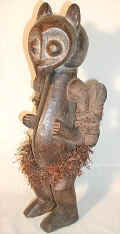
Yaka (Bayaka), Democratic Republic of the Congo
Ceremonial njila figurine.
The arts of the Yaka are very much
alive today. Ceremonial masks and figures are the work of a
sculptor who carries out his art well away from the view of other villagers.
The Yaka have an initiation, the n-khanda. A special hut is built in
the forest to give shelter to the postulants during their retreat; the event
ends in circumcision, an occasion for great masked festivities including
dances and song. The n-khanda is organized every time there are
enough eligible youths between ten and fifteen years of age. The njila
figurine represents a mythological bird. Placed in the interior of the
house, it protects against witches and other enemies that might cause
affliction. It is also placed in sleeping quarters where it functions as a
protective charm with strong fertility connotations. Besides, it is used in
some initiation ceremonies, and may also appear as mask. Its specific
function in the initiation is not clear.
Material: wood, raffia
Size: 17" x 8" x 6" |
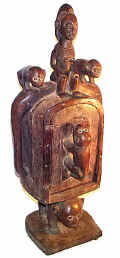
Yaka
(Bayaka), Democratic Republic of the Congo
The chest. Yaka
artistic tradition is rich and various, but much of it has been informed by
their neighbors – the Suku, the Kongo, the Holo and the Teke. The
beautifully carved chests of this kind have been used by diviners. This
piece is decorated by mythical subjects.
Material: wood
Size: 38" x 17" x 12" |
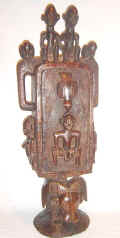
Yaka (Bayaka), Democratic Republic of the Congo
The chest. The Yaka
migrated from Angola during the 16th century and settled under
the control of the Kongo kingdom. In the 18th century their lands
were annexed by the Lunda people, but by the 19th century the
Yaka had regained their independence. Yaka society is tightly structured and
headed by a chief of Lunda origin, who delegates responsibilities to
ministers and lineage chiefs. The chests of this kind have been used by
diviners. This beautifully carved piece is decorated by mythical subjects.
Its specific purpose is unknown.
Material: wood
Size: 46" x 12" x 12" |
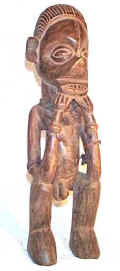
Yaka (Bayaka), Democratic Republic of the Congo
Mbwoolo
protective figurine.
Yaka means “males,” “the
strong ones,” thus Bayaka, “the strong people.”
The Yaka number about 300,000. They settled along the
middle Kwango River and along the Wamba River, in the southwest of the
country.
The tribe lives principally from hunting, although subsidiary farming is
undertaken by the women. They
cultivate manioc, yams, peas, pineapples and peanuts.
Young
men are expected to pass through various initiation stages, including
circumcision.
Highly artistic people, the Yaka give an aesthetic
touch to many everyday objects such as combs, pipes, musical instruments.
This figurine represents one of the Yaka tribe’s most widespread sculptural
categories. Its function is to protect people against evils. Typical are the
hands touching the chin, squatting posture, and protruding ears.
Material: wood
Size: 18" x 6" x 6" |
|

Yaka (Bayaka) or Suku, Democratic Republic of the Congo
Ceremonial kopa cup. The cups of
this type are supposed to have been used in marriage ceremonies, the bride
drinking palm wine from one side and the bridegroom from the other to seal
their union. Another source relates them to prestige objects connected with
leadership. The kopa was formerly one of the symbols of office
presented to a new chief or lineage headman upon his investiture. No one
else could touch it without proper authority. At the owner’s death, a
kopa was presented to his successor.
Material: wood
Size: 5" x 3" x 3" |
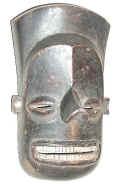
13" x 8" x 5" |

Yaka (Bayaka), Democratic Republic of the Congo
Ceremonial kopa cup. The cups of
this type are supposed to have been used in marriage ceremonies, the bride
drinking palm wine from one side and the bridegroom from the other to seal
their union. Another source relates them to prestige objects connected with
leadership. The kopa was formerly one of the symbols of office
presented to a new chief or lineage headman upon his investiture. No one
else could touch it without proper authority. At the owner’s death, a
kopa was presented to his successor.
Material: wood
Size: 8" x 3" x 3" |
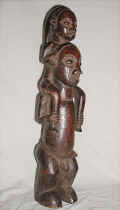
Yaka (Bayaka), Democratic Republic of the
Congo
Statue of the Chief. The
Kwango River area (southwest of the Democratic Republic of the Congo) is the
home of the Yaka and Suku, highly artistic peoples. Their institutions,
political organization, and cultural traditions are almost identical; they
can be differentiated only by the style of their statuary. The arts of the
Yaka numbering about 300,000 are very much alive today. The Yaka have
statues of chiefs which are not, however, portraits. This statue by its
composition is very close to the Yaka statue exhibited in the Museé Royal
de l’Afrique Centrale in Tervuren, Belgium. Its meaning is not known.
Material: wood
Size: 21" x 5" x 5" |

Yaka (Bayaka), Democratic Republic of the Congo
Ceremonial kopa cup. The cups of
this type are supposed to have been used in marriage ceremonies, the bride
drinking palm wine from one side and the bridegroom from the other to seal
their union. Another source relates them to prestige objects connected with
leadership. The kopa was formerly one of the symbols of office
presented to a new chief or lineage headman upon his investiture. No one
else could touch it without proper authority. At the owner’s death, a
kopa was presented to his successor.
Material: wood
Size: 3" x 6" x 4" |
|
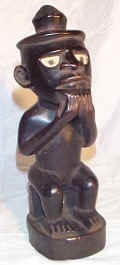 Mbwoolo
protective figure. Yaka means “the strong ones," “ba” means people,
thus Bayaka means ”the strong people.” Settled along the length of the
middle Kwango River, in the southwest of the country, they number about
300,000. The men traditionally practiced hunting, while the women
cultivated manioc, yams, peas, pineapples and peanuts. They practice
initiation and circumcision. Highly artistic people, the Yaka give an
aesthetic touch to many everyday objects such as combs, pipes, musical
instruments. The figure represents one of the Yaka tribe’s most widespread
sculptural categories. Typical are the hands touching the chin. Its function
is to protect people against evils. Mbwoolo
protective figure. Yaka means “the strong ones," “ba” means people,
thus Bayaka means ”the strong people.” Settled along the length of the
middle Kwango River, in the southwest of the country, they number about
300,000. The men traditionally practiced hunting, while the women
cultivated manioc, yams, peas, pineapples and peanuts. They practice
initiation and circumcision. Highly artistic people, the Yaka give an
aesthetic touch to many everyday objects such as combs, pipes, musical
instruments. The figure represents one of the Yaka tribe’s most widespread
sculptural categories. Typical are the hands touching the chin. Its function
is to protect people against evils.
Material: wood
Size:
12" x 5" x 5"
|
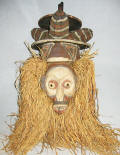
Yaka (Bayaka), Democratic Republic of the Congo
Yaka kholuka ceremonial mask.
Established in the southwest of DRC, the Yaka number some 300,000
individuals. The men traditionally practiced hunting, while the women
cultivated manioc, yams, peas, pineapples and peanuts. The masks are the
work of a sculptor who carries out his art well away from the initiation
enclosure, also separated from the view of other villagers. The sculptural
composition of this mask is typical of Yaka works. The face features are
painted with bright colors on white background. The ensemble is framed by
the sizeable mass of a coiffure in raffia fiber, this surmounted by a hat
made from armature of vegetable fiber and covered with a resin-coated
tissue. The kholuka mask which is very popular among the Yaka dances
alone at the end of celebrations. The whole mask refers to the power of the
elders and their predecessors, and every element of the mask is the plastic
translation of a cosmological term.
Generally such masks were used only once.
Material: wood, raffia, tissue
Size: 20" x 12" x 13" (30 w raffia) |
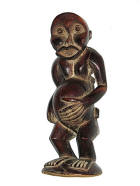
12" x 5" x 5" |
YORUBA
Nigeria,
Republic of Benin and Togo
The Yoruba people, numbering over 12 million, are the largest nation
in Africa with an art-producing tradition. Most of them live in southwest
Nigeria, with considerable communities further west in the Republic of Benin
and in Togo. They are divided into approximately twenty separate subgroups,
which were traditionally autonomous kingdoms. Excavation at Ife of
life-sized bronze and terracotta heads and full-length figures of royalty
and their attendants have startled the world, surpassing in their
portrait-like naturalism everything previously known from Africa. The
cultural and artistic roots of the Ife masters of the Classical Period (ca.
1050—1500) lie in the more ancient cultural center of Nok to the northeast,
though the precise nature of this link remains obscure.
Now two-third of the
Yoruba are farmers. Even if they live in the city, they keep a hut close to
the fields; they grow corn, beans, cassava, yams, peanuts, coffee, and
bananas. It is they who control the markets -- along with the merchants and
artisans: blacksmiths, copper workers, embroiderers, and wood sculptors,
trades handed down from generation to generation.
The Yoruba gods form a
true pantheon; the creator god, Olodumare, reigns over almost four hundred
orisha (deities) and nature spirits who live among the rocks, trees,
and rivers. Their figures, more often of Shango (also spelled Sango and
Sagoe), deity of thunder and lightning are carved from wood and kept in
shrines. Sculptors have studios in which apprentices learn the techniques of
the master and his stylistic preferences. Throughout Yorubaland, human
figures are represented in a fundamentally naturalistic way, except for
bulging eyes; flat, protruding, and usually parallel lips; and stylized
ears. Within the basic canon of Yoruba sculpture, many local styles can be
distinguished, down to the hand of the individual artist. Today, Nigeria is
structured by a number of cults. The Gelede cult pays homage to the
power of elderly women. During Gelede festivities, helmet masks
carved in the form of a human face are worn. On top of the head there is
either an elaborate coiffure or a carved representation of a human activity.
The masks of the Epa cult, which is connected with both the ancestors
and agriculture, vary enormously according to the town in which they appear.
The mask proper, roughly globular, has highly stylized features that vary
little; but the superstructure, which may be four feet or more in height, is
often of very great complexity. Generally, they are worn during funerals or
rites of passage ceremonies and characteristically they are composed of many
elements – usually a human-face helmet mask topped by an elaborate standing
figure. When not worn, these masks are kept in shrines where they are
honored with libations and prayers. The Ogboni society brass figures,
called Edan, are cast in pairs and attached to spikes and a chain
runs from head to head to join the pair. They are worn over the shoulders of
Ogboni members as sign of office or as an amulet. Large brass figures,
called onile, are carved as a pair and represent the male and female
aspects of Ile, the earth Goddess. A variety of palm nut containers
used for divination are made with caryatides depicting women. Societies and
cults still hold celebrations today during the many masked festivities in
which costumes of fiber or fabric, masks, music, and dance form one
interlocking whole. The most widely distributed cult is of twins, ibeji,
whose birth among the Yoruba is unusually frequent. An ibeji
statuette is to be made, if one twin died; this ibeji remained with
the surviving twin and was treated, fed, and washed as a living child. Their
effigies, made on the instructions of the oracle, are among the most
numerous of all classes of African sculpture. The equestrian figure is a
common theme in Yoruba wood sculpture. It reflects the
importance of the cavalry in the campaigns of the kings who created the Oyo
Empire as early as the sixteenth through the eighteenth centuries. Only
Yoruba chiefs and their personal retainers were privileged to use the horse.
Nevertheless, the rider and the horse remained an important social symbol
and offered an exciting subject for artistic imagination and skill.
The diminutive animal and the dwarfish legs of the horseman are
typical for this type of figures. Carved doors and house posts are found in
shrines and palaces and in the houses of important men. Fulfilling purely
secular functions are bowls for kola nuts, offered in welcoming a guest;
ayo boards for the game, known also as wari, played with seeds or
pebbles in two rows of cuplike depressions; and stools, spoons, combs, and
heddle pulleys. Additional important arts include pottery, weaving,
beadworking and metalsmithing. |
|
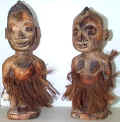
Yoruba (Yorba, Yorouba), Nigeria, Benin and Togo
Ibeji (twins) statuettes.
The Yoruba people, numbering over
12 million, are the largest nation in Africa with an art-producing
tradition. The ibeji statuette is a minor art
form. The great frequency of twin births and the heightened infant mortality
rate have found sculptural expression in the Yoruba territory through
ibeji figurines. Sculpted at the sign of the diviner at the death of one
or both twins, they are looked after and venerated by the mothers, who feed
them, clothe them and ritually wash them because they are depositories of
the spirits of the children. A lack of attention could provoke the ire of
the spirits and bring disastrous results. Thus the ibeji are Yoruba
memorials to twins who have died. Twins are believed to be the children of
Shango, the god of thunder and lightning. They are also thought to possess
supernatural powers and share the same soul.
Material: wood, vegetable fiber
Size: 9" x 4" x 3" & 8" x 3" x
4" |
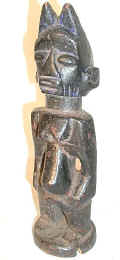 Yoruba
(Yorba, Yorouba), Nigeria, Benin and Togo. Yoruba
(Yorba, Yorouba), Nigeria, Benin and Togo.
Statue |
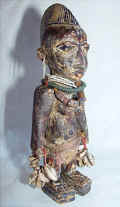 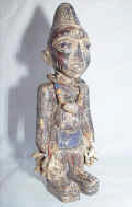
Yoruba (Yorba, Yorouba), Nigeria, Benin and Togo
Ibeji (twin) female statuette.
The Yoruba people, numbering over
12 million, are the largest nation in Africa with an art-producing
tradition. The ibeji statuette is a minor art
form. Societies and cults still
hold celebrations today during the many masked festivities in which costumes
of fiber or fabric, masks, music, and dance form one interlocking whole. The
most widely distributed cult is of twins, ibeji, whose birth among
the Yoruba is unusually frequent. An ibeji statuette is to be made,
if one twin died; this ibeji remained with the surviving twin and was
treated, fed, and washed as a living child. Their effigies, made on the
instructions of the oracle, are among the most numerous of all classes of
African sculpture. A lack of attention could provoke the ire
of the spirits and bring disastrous results. Thus the ibeji are
Yoruba memorials to twins who have died. Twins are believed to be the
children of Shango, the god of thunder and lightning. They are also thought
to possess supernatural powers and share the same soul.
Material: wood, tissue, beads |
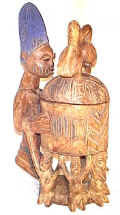
Yoruba (Yorba, Yorouba), Nigeria, Benin and Togo
Olumeye
female figure.
The Yoruba people, numbering over 12 million, are the largest nation in
Africa with an art-producing tradition. Most of them live in southwest
Nigeria, with considerable
communities further west in the Republic of Benin and in Togo,
in an area of forest and savannah.
They are divided into approximately twenty separate subgroups, which were
traditionally autonomous kingdoms. Now two-third of the Yoruba are farmers.
Even if they live in the city, they keep a hut close to the fields; they
grow corn, beans, cassava, yams, peanuts, coffee, and bananas. It is they
who control the markets -- along with the merchants and artisans:
blacksmiths, copper workers, embroiderers, and wood sculptors, trades handed
down from generation to generation. Olumeye means “one who
knows honor” and some Yoruba carvers referred to the female figure as “a
messenger of the spirit” who carries cola and cakes in an offering bowl.
Carvings of this type were used in the reception room of the palace to hold
kola nuts, which were given to the guests as an act of hospitality and for
their refreshment. The hornbills on the top of bowl are symbols of
fecundity.
Material: wood
Size: 27" x 10" x 17
|
|
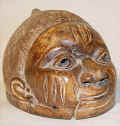
Yoruba (Yorba, Yorouba), Nigeria, Benin and
Togo
Gelede Mask.
The Gelede cult pays homage
to the power of elderly women who ensure the fertility and
well-being of the community, but who are also held responsible for human
barrenness and death. The mask
festivals called Efe/Gelede are celebrated among the subgroups of the
southwestern Yorubaland. It is usually held between March and May, when the
rains arrive and a new agricultural cycle begins. The masquerades, songs,
and dances are in honor of “our mothers,” whose power is especially manifest
in elderly women, female ancestors, and female orisha (goddesses).
Through song, dance, and costume, the underlying truth of
the power and authority of woman in a male-oriented society is acknowledged.
During Gelede festivities,
the masks of this type carved in the form of a human face are worn.
Material: wood
11" x 9" x 7" |
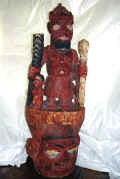
Yoruba (Yorba, Yorouba), Nigeria, Benin and Togo
Epa
mask.
The
epa cult is connected with the ancestors and agriculture. The epa
masks have highly stylized features that vary little; but the
superstructure, which may be four feet or more in height, is often of very
great complexity. In the concluding ritual of the epa festival, the
excitement and expectation of the participants mount as the last of the
great masks appear from the forest to dance among the townspeople and
receive the great homage of the chiefs and elders of the community. This
mask is imaging the beauty and power of woman. The mask comes from the
forest with measured pace and great dignity. She is referred to as “the
leader” of all the women of the
community. As she dances gracefully the masker receives and acknowledges the
praises of the people, especially those of the women, who call for her
blessing and aid in bearing children. Epa masks remember “the great
ones of the family who are now dead”.
Material: wood
|
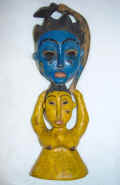 Yoruba Yoruba |
YAURE
(SNAN, YAOURE, YAURE)
Côte d'Ivoire
The 20,000 Yohure inhabit the central region of the Côte d’Ivoire, the
territory between the White and Red Bandama Rivers, to the east of the city
of Bouafle. The Yohure are geographically and linguistically situated
between the Baule, an Akan language group to the east, and the Guro and Gban
(Gagu), southern Mande-speaking peoples to the west. Depending upon their
proximity to their neighbors, the inhabitants of Yohure villages are either
entirely Baule or Mande speaking. Villages are generally associated with one
clan. They are governed by a leader assisted by a council of elders who
represent each family holding. Each family lineage traces his roots to a
particular ancestor. Not only their language, but also the culture, religion
and art are influenced by their powerful neighbors, the Baule and Guro. The
Yohure possess a strong sense of identity and have evolved a refined art.
The Yohure decorate different everyday objects with figurative
representations, but first of all their beautiful masks reveal their
artistic abilities.
The masks of the Yohure represent human
faces often supplemented by animal attributes. They have an elongated
face with a protruding mouth and pierced semi-circular eyes set under a
high forehead. An elaborate plaited coiffure parted on each side, often
with horns at the end, completes the image, while the outline of the
mask is characteristically surrounded by a serrated edge. The masks are
considered emblems of yu spirits, very dangerous; they have to be
handled with extreme caution. Cases of death that jeopardize the social
order are the principal occasions for an appearance of masqueraders. By
means of their dance, they restore the social equilibrium of the
community and accompany the deceased into the ancestral realm. These
masks are worn predominantly on two occasions: the je
celebration and the lo ceremony. The
first purifies the village after a death and helps the deceased's soul
on its way to a final resting place. Painted masks are mainly worn by
dancers during this ceremony, while for lo
funeral ceremony masks covered with black pigments appear. Women may not
participate in funeral ceremonies, neither may they look at the masks,
for fear that this encounter with death might jeopardize their
fecundity. This means that before starting the village’s purification
rituals related to a death, for prudence sake the women are gotten out
of the way. With the aid of such masks, the people hope to influence
supernatural powers, or yu spirits, that can do harm to humans,
but that can also ensure their welfare. The function of each type of
mask is not rigidly fixed, which leads to their appearance during either
ceremony.
Small Yohure statuettes are carved to
protect and help in difficult situations. They have realistic features
with the emphasis placed on the head. The Yohure use drums to announce
the death of a chief.
|
|
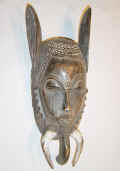
Yohure (Snan, Yaoure, Yaure),
Côte d’Ivoire
Cereminial je mask.
For the Yohure, the masks
are representations of the yu spirits, intermediates between Bali,
the supreme creator, and humankind. The majority of Yohure masks play a
fundamental role in restoring order to a society deeply distressed by
bereavement. Indeed, a death throws the village out of balance, and only the
intervention of the yu spirit – by way of the masks – can counter.
The present mask is a member of the je mask series of the men’s
initiation association. The mask combines animal and human features in an
emblematic evocation of one of the “spirit powers” of the bush which the
Yohure call yu. As intermediaries between man and god (Bali),
yu are sacrificed to during times of peril and when there is a threat
to the social order. The je masks, as evocations of yu, are
considered to be extremely powerful objects and very dangerous to touch
outside their ritual context. Mythological sanction absolutely prohibits
women from seeing the masks and from attending the funeral rites at which
they appear.
Material: wood
16" x 6" x 4" |
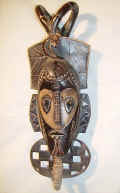 Cereminial lo mask.
The 20,000 Yohure inhabit the central
region of the Côte d’Ivoire. For the Yohure, the masks are representations
of the yu spirits, intermediates between Bali, the supreme
creator, and humankind. The majority of Yohure masks play a fundamental role
in restoring order to a society deeply distressed by bereavement. Indeed, a
death throws the village out of balance and, moreover, is an indelible stain
that only the intervention of the yu – by way of their lo
masks – can counter. In order for the yu to be able to liberate their
purifying powers, it is necessary for man to court their favor. The yu
masks may be benevolent or, conversely, extremely dangerous; thus, it is
necessary to appease them via sacrifices offered to their masks. The lo
masks appear during funeral ceremonies. Women may not participate in
funeral ceremonies, neither may they look at the masks, for fear that this
encounter with death might jeopardize their fecundity. This means that
before starting the village’s purification rituals related to a death, for
prudence sake the women are gotten out of the way. In addition to this
purifying function, the masks are also used to guide the deceased’s soul to
the world of the dead, and to assure him the status of an ancestor
protective of his descendants. This is of the utmost importance, for there
is nothing as dangerous or disquieting as an errant soul loose in the
village. The outline of the mask is characteristically
surrounded by a serrated edge. The function of each type of mask is not
rigidly fixed. Cereminial lo mask.
The 20,000 Yohure inhabit the central
region of the Côte d’Ivoire. For the Yohure, the masks are representations
of the yu spirits, intermediates between Bali, the supreme
creator, and humankind. The majority of Yohure masks play a fundamental role
in restoring order to a society deeply distressed by bereavement. Indeed, a
death throws the village out of balance and, moreover, is an indelible stain
that only the intervention of the yu – by way of their lo
masks – can counter. In order for the yu to be able to liberate their
purifying powers, it is necessary for man to court their favor. The yu
masks may be benevolent or, conversely, extremely dangerous; thus, it is
necessary to appease them via sacrifices offered to their masks. The lo
masks appear during funeral ceremonies. Women may not participate in
funeral ceremonies, neither may they look at the masks, for fear that this
encounter with death might jeopardize their fecundity. This means that
before starting the village’s purification rituals related to a death, for
prudence sake the women are gotten out of the way. In addition to this
purifying function, the masks are also used to guide the deceased’s soul to
the world of the dead, and to assure him the status of an ancestor
protective of his descendants. This is of the utmost importance, for there
is nothing as dangerous or disquieting as an errant soul loose in the
village. The outline of the mask is characteristically
surrounded by a serrated edge. The function of each type of mask is not
rigidly fixed.
Material: wood
Size:
23" x 8" x 4" |
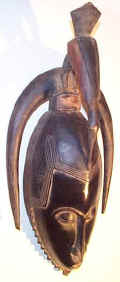 Yohure
(Snan, Yaoure, Yaure), Côte d’Ivoire Yohure
(Snan, Yaoure, Yaure), Côte d’Ivoire
Cereminial mask. The best known
masks of the Yohure, a small ethnic group onhabiting the central region of
Côte d’Ivoire, represent human faces supplemented by animal attributes. They
belong to the Je or Lo types of masks that are difficult to
distinguish from one another. With the aid of such masks, the people hope to
influence supernatural powers, or yu, that can do harm for humans,
but that can also ensure their welfare. The masks are considered emblems of
yu, extremely dangerous, to be handled with extreme caution, and
absolutely kept out of the sight of women. Cases of death that jeopardize
the social order are the principal occasions for an appearance of
masqueraders. By means of their dance, they restore the social equilibrium
of the community and accompany the deceased into the ancestor realm.
Material: wood
24" x 11" x 7" |
YOMBE
(BAYOMBE, MAJOMBE, MAYOMBE, MAJUMBA, MAYUMBE,
YUMBE)
Both Congo Republics and Angola
Due to the thick forests surrounding Yombe territory the land must be
cleared through slash and burn techniques before crops can be planted. The
land is usually cleared by men, leaving the task of farming to the women.
Plantains, manioc, maize, beans, peanuts, and yams are among the primary
crops grown. These are primarily used for local consumption, but surplus is
also sold in regional markets to obtain cash. Goats, pigs, chickens, and
dogs are also raised. Fishing on the Congo (Zaire) river and its surrounding
tributaries provides an important source of dietary protein. Men are also
responsible for hunting, weaving, carving, smithing, and smelting. Women
create clay pots for domestic use.
The forested region of the Lower Zaire River is important in the artistic
history of black Africa, because it boasts the greatest concentration of
maternity figures and stone statuary. The focal point is the vast Yombe area
where numerous individual styles may be found. The Kongo kingdom influenced
the Yombe who, at one point of their history, were an integral part of this
kingdom. The 350,000 Yombe people are artistically prolific. They produced
some of the finest sculpture in all Africa. Their statues contained the same
themes as the Kongo's: maternity figures, seated kings, objects of prestige,
and nail and mirror fetishes. The Yombe female phemba statues are
used in divinatory practices or associated with fertility rites.
Phemba figures represent women in seated, cross-legged, or kneeling
poses with pointed or round coiffures, necklaces of glass or coral beads, a
cord tied around the breasts, jewelry, and filed teeth. Women are an
important Yombe symbol since they are considered to be not only a nurturing
force, but also seers and guardians of the spirit. The maternity figures are
carved of wood in a realistic style, rare in Africa. Mirror and nail
fetishes have an aggressive expression characterized by an open mouth
usually showing filed teeth. The rare realistic masks were worn during
important communal ceremonies. The art of the royal court is manifested in
objects of luxury such as commanders’ staffs, flyswats, scepters, swords,
and musical instruments such as drums, trumpets and whistles. The mvuala
scepter are ordinarily surmounted by refined female figures; sometimes they
contain relics. |
|
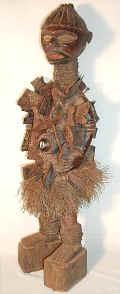
Kongo
(Bakongo, Bashikongo, Kakongo), Angola and Democratic Republic of the Congo
Nail Fetish. Nail
fetishes are a unique and important phenomenon of Kongo sculpture. In the
Kongo, all these fetishes are called nkisi. Nkisi means
“medicine”. Historically, there were two types of nkisi, public and
private, with some having vital democratizing roles, as sources of
empowerment for rural residents and individuals
outside the court.
In order to face certain trials (illness, conflict,
sterility, sorcery, etc), the Kongo take recourse in this type of object.
Inserting nails or pieces of metal into the nkisi to tie down an
agreement or lawsuit is called bibaaku. It activates the figure to
bring destruction to those who do not fulfill their end of the pact, oath,
or treaty. Thus they attempt to resolve their problem, or to intimidate or
punish the individual responsible for it. An nkisi is made by a
sculptor who works together with a nganga (ritual expert). The
sculptor carves a male figure. Next, the nganga completes the figure
by placing the ingredients that have positive or negative power in an
abdominal cavity made by the sculptor. These ingredients are ‘carriers’ for
a variety of magical objects, which can be sand, roots or leaves, or other
objects. Keeping track of the precise history of each insertion was the duty
of the nganga. As one source says, the nkisi is “a hiding
place for people’s souls, to keep and compose in order.
Material: wood, nails, pieces of
metal, vegetable fiber, raffia, cowrie
Size: 34" x 11" x 10" |
ZANDE
ZANDE (ADYO, AZANDE, BADJO, BAZENDA, BSANDE,
IDIO, NIAM-NIAM, ZANDEH)
Central African Republic, Democratic Republic
of the Congo, Sudan
The word azande means "the people who
possess much land." This relates to their history as conquering warriors.
The Zande migrated during the 18th century from Sudan to the northern part
of the Democratic Republic of the Congo, settling on the banks of the Uele
River. They live also in the Central African Republic and the Sudan. They
occupy a region of savanna and forest and in common with the Mangbetu, Zande
men hunt and fish while the women tend the fields. In political terms, this
ethnic group of 750,000 people is ruled by a king with succession to the
throne passing to his eldest son, while the younger ones govern the
kingdom's provinces. The Zande have been ruled by different members of a
single royal dynasty, the Avangara. Royal patronage was significant in the
development and movement of art throughout this area. The political
structure is counterbalanced by the mani
secret association, created at the end of the 19th century.
Zande sculptures
represent ancestors or animal figures with simplified features and enlarged
heads. The mani association celebrates the
importance of woman and uses statuette called yanda.
These statues are associated with the highest rank of the secret mani
society. The figures protect society members from the dangers of illness,
hunting, evil spirits, etc. Usually female figures are made from wood or
fired clay; yanda figures often wear accessories, such as bead
collars, pendants, and coins. The society's chief would infuse the
yanda with his power by blowing smoke on it and
rubbing it with a paste. The pyramid-shaped head, simple in form, has a
diamond-shaped face, protruding eyes, and, often, iron rings in its ears and
nose. The torso and neck are cylindrical or rectangular, the extremities
short. Its outlines are angular and abstract. In some northern Zande areas,
large pole-like figures have been erected. These figures may have functioned
as grave markers, a widespread pattern for eastern Africa and the southern
Sudan. The maternity figures are also known, as are stylized and refined
objects: neck-rests, flyswats, ivory horns, and musical instruments such as
drums, sanzas, and curved harps decorated with a head and ending with a pair
of legs. Masks are rare.
|
|

Zande (Azande, Bsande, Niam-Niam) (?),
Democratic Republic of Congo
Yanda
protective statuette. The statuettes of this type are associated with the highest rank of the
secret Mani society. Named for the society’s protective spirit, the
figurine protects society members from the dangers of illness, hunting, evil
spirits, etc. Usually they are female figurines made from wood or fired
clay.
Material: wood.
Size: |
|
Total
items this page |
78 |